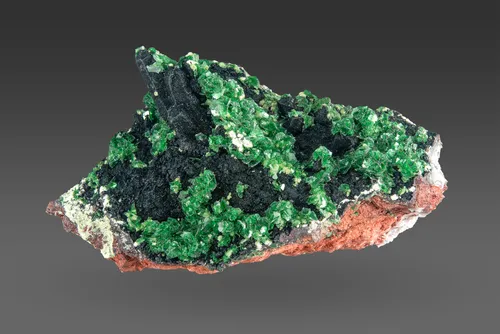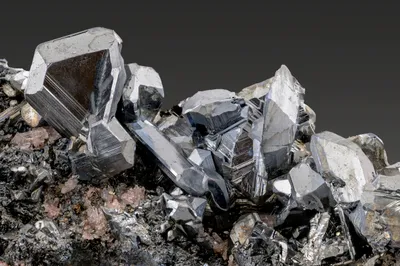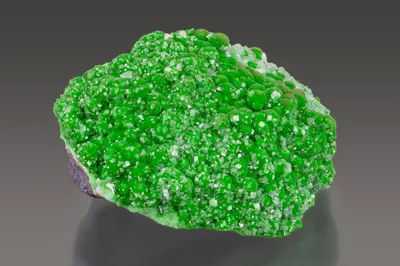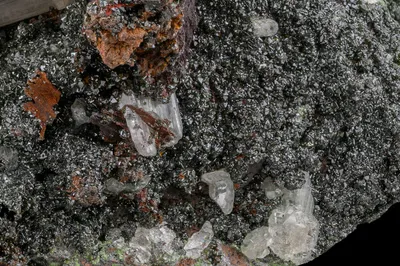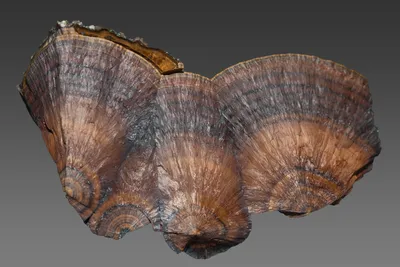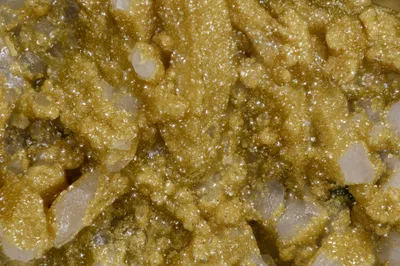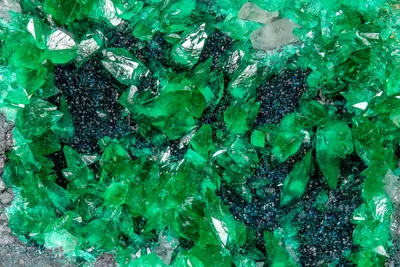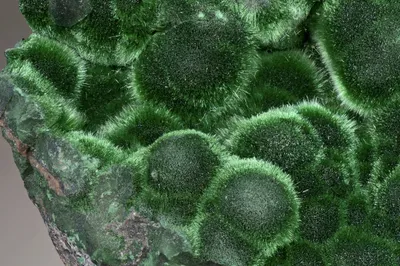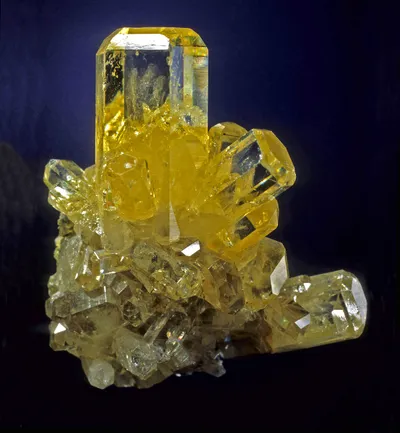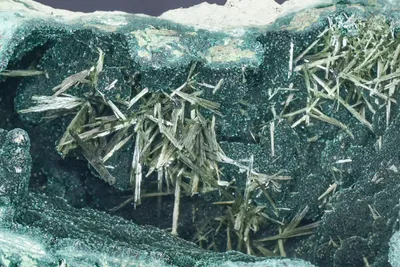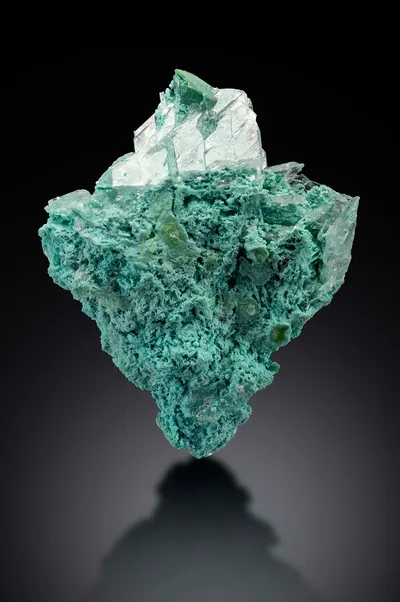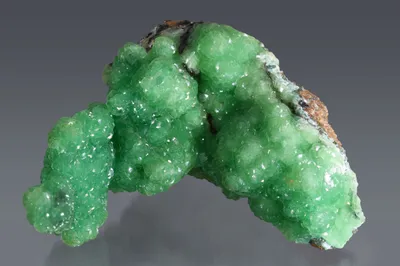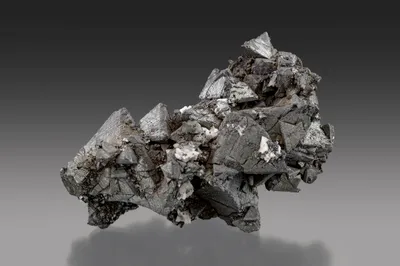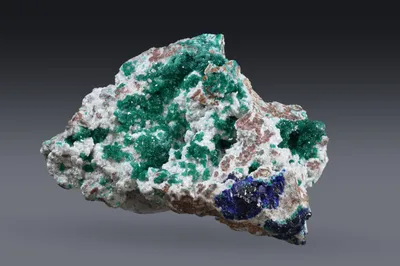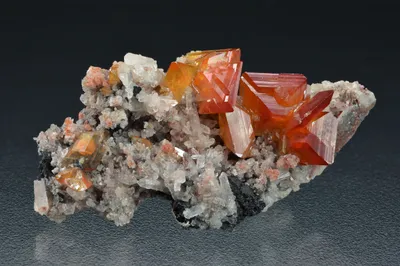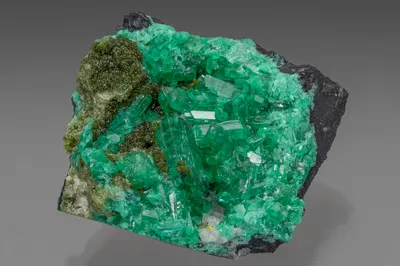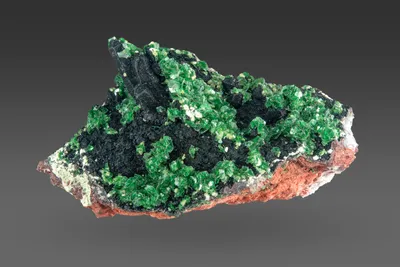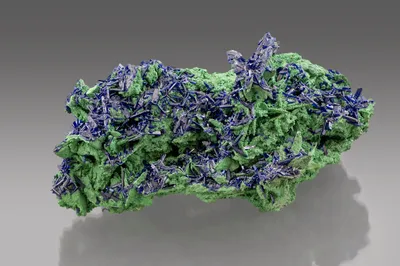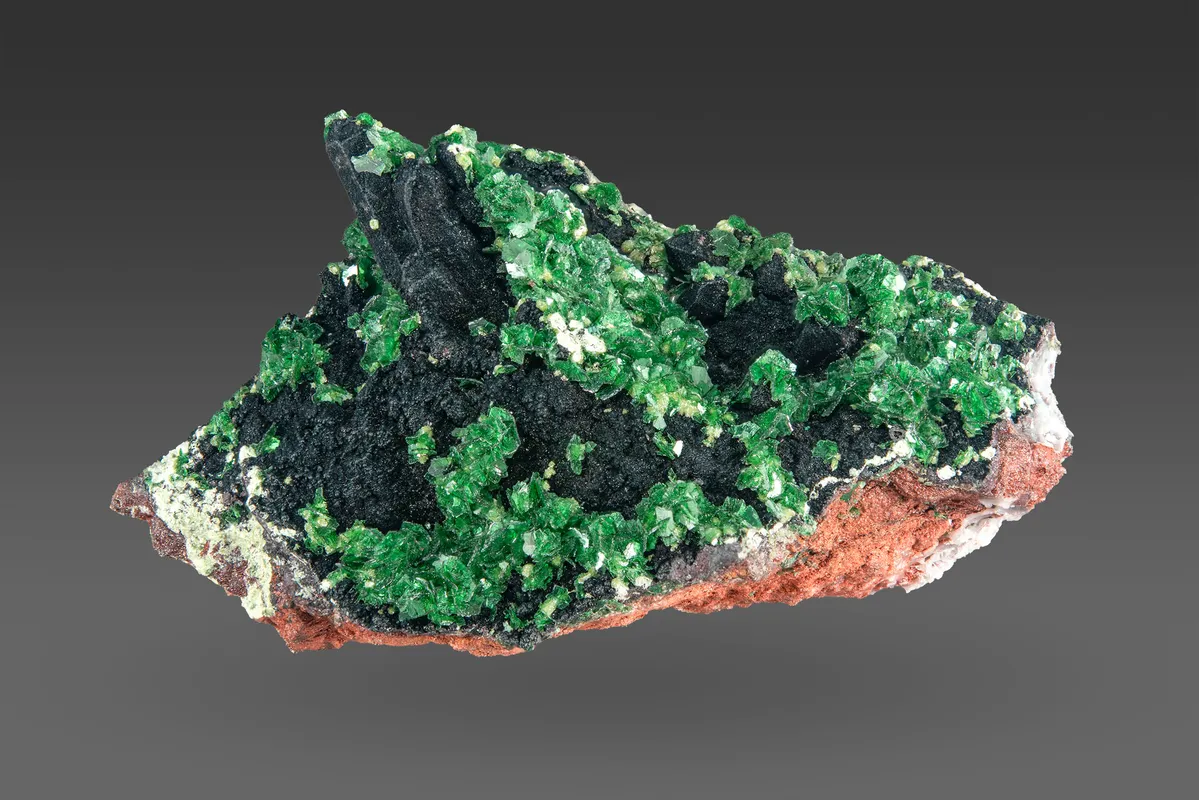
Image Credit: Malcolm Southwood
Mineral Species
Bayldonite
Type Locality
No
Composition
PbCu3(AsO4)2(OH)2
Crystal System
Monoclinic
Status at Tsumeb
Confirmed
Abundance
Common
Distribution
First and second oxidation zones
Paragenesis
Supergene
Entry Number
Species; TSNB42
General Notes
Bayldonite was recorded at Tsumeb from the earliest years of mining (Maucher, 1908a). There was, however, a tendency among early observers to use "bayldonite" as a generic term for unidentified copper arsenates or mixtures thereof; accordingly, some early specimens of undetermined (or at the time undescribed) arsenates are erroneously, or simplistically, identified as "bayldonite".
Bayldonite is a common (but by no means ubiquitous) component of the massive, powdery mixtures of copper and copper-lead secondary minerals that were particularly abundant in the upper portion of the first oxidation zone (between the surface and 9 Level). Such material ranges in colour from yellow-green, through apple-green, to dark green and forms the matrix for many first oxidation zone specimens of azurite, cerussite, malachite (after azurite), olivenite or zincolivenite crystals. A preliminary study (by powder XRD) of such matrix materials from specimens in the collections at MGMH (notably from the Klein Collection and from specimens obtained during Charles Palache’s visit to Tsumeb in 1922) has identified bayldonite in earthy mixtures with (variously) arsentsumebite, cerussite, conichalcite/duftite, gartrellite, malachite and smithsonite (M. Southwood; unpublished data). Visually, in these occurrences, bayldonite is almost impossible to distinguish and easily confused with other arsenates such as arsentsumebite conichalcite/duftite and gartrellite.
It is notable that the first oxidation zone material characterised as ‘arsentsumebite’ by Vésignié (1935) was, in fact, a mixture of bayldonite and duftite (Guillemin 1956).
Numerous specimens of "bayldonite" coating, or replacing mimetite were recovered from the upper portion of the first oxidation zone during the early years of mining at Tsumeb. The majority of such specimens were recovered from between the surface and 5 Level (Southwood 2022b). Pufahl (1920) noted "bayldonite" pseudomorphs after mimetite up to 10 cm in length, although replacements to 30 cm were later recorded (Von Bezing et al. 2007).
Modern studies of these pseudomorphs has shown that the replacements are a little more complex. Pinch and Wilson (1977) suggested that some of the lighter-colored examples are of tsumebite after mimetite (although it is probable that they mistook arsentsumebite for tsumebite). Keller (1984) commented that the pseudomorphs can consist of bayldonite, arsentsumebite or tsumebite but, once again, tsumebite seems questionable. Gebhard (1999) proposed that in many cases mimetite is coated or replaced by bayldonite which in turn is replaced by arsentsumebite. It is notable that duftite also forms pseudomorphs after mimetite although whether these replacements sometime involve mixtures of duftite with bayldonite (or arsentsumebite) is uncertain.
Recent XRD and EMPA studies have confirmed that at least some of these pseudomorphs, perhaps a majority, are mixtures of arsentsumebite and bayldonite replacing mimetite. The ratio of bayldonite to arsentsumebite varies considerably but seems to increase with the extent of the replacement; that is, pseudomorphs retaining a core of mimetite tend to a higher proportion of arsentsumebite, while pseudomorphs in which the mimetite has been completely replaced tend to be bayldonite-dominant (Martin Števko, pers. comm. April 2024).
Well-formed crystals of bayldonite are more typical of the second oxidation zone notwithstanding the fact that bayldonite is much scarcer in the deeper levels of the mine.
Specimens from the 1973 discovery of doubly terminated crystals, believed to have been found on 28 Level (Key, 1977) were described as best of species by Pinch and Wilson (1977). Greenish-black, highly lustrous, blocky crystals (to 10 mm) are associated with zincolivenite, schultenite and keyite in a vuggy tennantite-rich matrix. These crystals are pseudo-scalenohedral trillings, with a composition plane (311) (Cesbron and Vachey 1974; Anthony, et al. http://www.handbookofmineralogy.org/; accessed December 2019). Very few specimens of this habit were recovered but an excellent example is conserved in the Pinch Collection at Harvard University (MGMH 2020.7.700).
Platy crystals of pseudohexagonal, bottle-green to dark green bayldonite, tabular on (001), were discovered in 1980 according to Von Bezing et al. (2007). Specimens of this habit were well-represented in the collection of the late John Innes, although his specimens display two very different parageneses, probably indicating more than one discovery (E. H. Nickel, Catalogue of the John Innes Collection; c. 1993, unpublished). The first of these associations comprises bright green micaceous crystals of bayldonite (to 1.5 mm) on a substrate of pale green, chalky "β-duftite" with quartz crystals and hematite over a siliceous matrix. The second consists of similar balydonite crystals on a carpet of a yellow botryoidal mineral that Nickel (c. 1993, Catalogue of the John Innes Collection, unpublished) believed to be a member of the tsumcorite group, occupying vugs in partly oxidised massive sulphide ore.
Pseudo-rhombohedral crystals of bayldonite have also been noted (Von Bezing et al. 2007), but the location in the mine at which they were found is not known.
Keller (1977a) noted that bayldonite is rare in the second oxidation zone and "… commonly mis-identified". He described thin yellow-green crusts of bayldonite (resembling duftite) on cm-sized mimetite crystals, and a single "…beautiful specimen [consisting] of 2-4 mm blackish green crystals not intergrown with any other mineral". Inexplicably, however, bayldonite is missing from Keller’s (1984) alphabetical listing of Tsumeb minerals.
Associated Minerals
anglesite; arsentsumebite; azurite; chalcocite; conichalcite; dolomite; duftite; gartrellite; goethite; hematite; hidalgoite; keyite; malachite; mimetite; olivenite; philipsbornite; quartz; schultenite; smithsonite; tennantite-(Zn); tsumebite; wulfenite; zincolivenite
Pseudomorphs
Bayldonite has been reported to form pseudomorphs after the following minerals: azurite (rare); cuprite (rare); dolomite (rare); mimetite (common); tennantite (rare); wulfenite (rare).
The following minerals have been reported to form pseudomorphs after bayldonite: arsentsumebite (rare); olivenite (rare).
